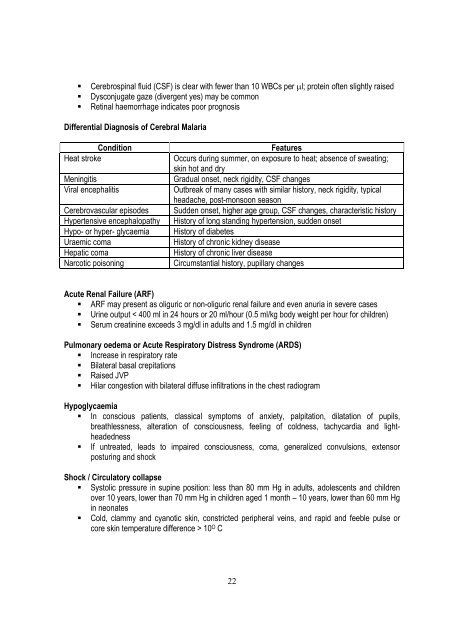training module for medical officers primary health centre - NVBDCP
training module for medical officers primary health centre - NVBDCP
training module for medical officers primary health centre - NVBDCP
- No tags were found...
Create successful ePaper yourself
Turn your PDF publications into a flip-book with our unique Google optimized e-Paper software.
Cerebrospinal fluid (CSF) is clear with fewer than 10 WBCs per l; protein often slightly raisedDysconjugate gaze (divergent yes) may be commonRetinal haemorrhage indicates poor prognosisDifferential Diagnosis of Cerebral MalariaConditionHeat strokeMeningitisViral encephalitisCerebrovascular episodesHypertensive encephalopathyHypo- or hyper- glycaemiaUraemic comaHepatic comaNarcotic poisoningFeaturesOccurs during summer, on exposure to heat; absence of sweating;skin hot and dryGradual onset, neck rigidity, CSF changesOutbreak of many cases with similar history, neck rigidity, typicalheadache, post-monsoon seasonSudden onset, higher age group, CSF changes, characteristic historyHistory of long standing hypertension, sudden onsetHistory of diabetesHistory of chronic kidney diseaseHistory of chronic liver diseaseCircumstantial history, pupillary changesAcute Renal Failure (ARF) ARF may present as oliguric or non-oliguric renal failure and even anuria in severe cases Urine output < 400 ml in 24 hours or 20 ml/hour (0.5 ml/kg body weight per hour <strong>for</strong> children) Serum creatinine exceeds 3 mg/dl in adults and 1.5 mg/dl in childrenPulmonary oedema or Acute Respiratory Distress Syndrome (ARDS) Increase in respiratory rate Bilateral basal crepitations Raised JVP Hilar congestion with bilateral diffuse infiltrations in the chest radiogramHypoglycaemia In conscious patients, classical symptoms of anxiety, palpitation, dilatation of pupils,breathlessness, alteration of consciousness, feeling of coldness, tachycardia and lightheadedness If untreated, leads to impaired consciousness, coma, generalized convulsions, extensorposturing and shockShock / Circulatory collapse Systolic pressure in supine position: less than 80 mm Hg in adults, adolescents and childrenover 10 years, lower than 70 mm Hg in children aged 1 month – 10 years, lower than 60 mm Hgin neonates Cold, clammy and cyanotic skin, constricted peripheral veins, and rapid and feeble pulse orcore skin temperature difference > 10 O C22
















